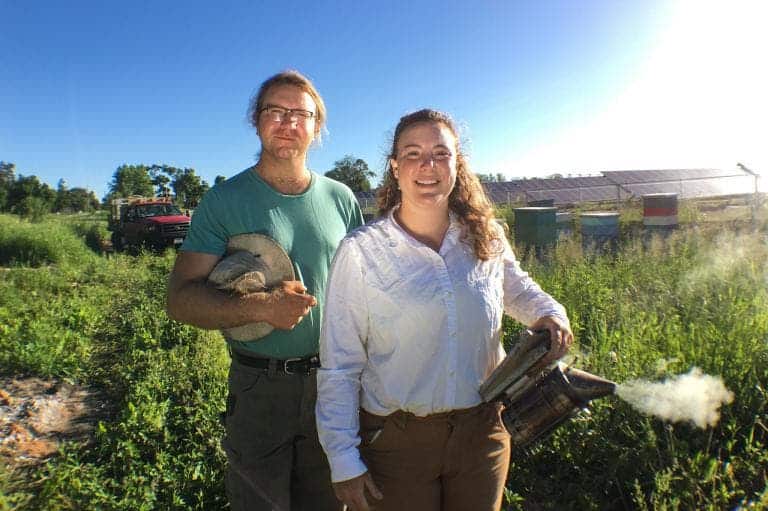Solar energy is gaining a lot of traction at the moment, as it’s getting cheaper and cheaper and provides renewable, green energy. But one of the valid concerns regarding solar energy is that it often replaces agricultural fields, competing with plants for the same resource: sunlight. Wind energy can somewhat bypass that problem because you can grow plants around turbines, but in the case of solar, there’s no getting around it. Well, that doesn’t mean you can’t use the land for anything else — in fact, as a new project shows, you can use quite brilliantly.
Beehives and solar panels

If you’d visit the SolarWise garden in Ramsey, Minnesota, you’d probably be a bit surprised. For starters, it doesn’t look like a cutting edge facility. In fact, it almost looks… a bit raw. Instead of the usual gravel or neatly cut grass you’d expect to find under the solar panels, you’ll find cute flowers and some vegetation you’d expect to see in a wild field, not a human facility. This isn’t just random field, it’s pollinator-friendly vegetation, and in April, the garden became the first solar facility to host commercial beekeeping.
Two other arrays are now doing the same thing in Minnesota, and the trend is spreading surprisingly fast. The start-up behind this unusual idea is called Bolton Bees, and is the brainchild of married couple Travis and Chiarra Bolton.
“It’s been pretty amazing how fast it’s caught on,” Travis says. “My phone rings almost constantly.” According to National Geographic, the Boltons are in talks to install apiaries at more solar projects in Minnesota, Wisconsin, Iowa, and Illinois.
It seems really bizarre at first, having something as advanced as a solar panel array with flowers and beehives, but the more you look at it, the more interesting and appealing it becomes. First, it offers a unique opportunity to actually use the land around solar panels. These arrays can cover quite a lot of land, and take up a lot of sun — so regular agricultural practices become impossible. But the flowers they chose aren’t really picky, they can just grow around the panels, and you don’t need a lot of them to feed the bees.
About the bees themselves, at first, you might think that’s insane. But it’s really not; the bees don’t interact with the panels in any way. The beehives are placed a bit outside the arrays, and the bees just take what they need from the flowers, not bothering anyone. After that, they just hang around their hives, outside the solar array. They almost always tend to avoid the panels because they get quite hot. So the bees aren’t interfering with the solar energy. Even more importantly, this opens new avenues for growing bees, as the insects have been in dire straits in recent years. In the US, beekeepers lost 40 percent of their colonies in 2016 alone, with similar trends in many parts of the world. Due to a number of causes, the leader of which seems to be pesticides, bee numbers are plummeting. Having this new way to support bees offers a new hope.
Basically, it’s a match made in heaven — you get clean energy, use additional land, get an additional source of revenue (through honey), and support bees, which are extremely important for agriculture and for the environment.
The Tesla of honey

The advent of renewable energy has brought an increase of awareness — people are starting to realize that renewable energy isn’t really bad for the economy; on the contrary, it’s key for sustainable development. Thankfully, it seems that the same is starting to happen for bees too. Coupling solar arrays with meadows is already taking place in Europe (though it’s quite novel in the US), but adding hives into the mix might be one of those crazy ideas that just works.
Rob Davis, director of Fresh Energy’s media and innovation program, has started working with Bolton Bees, says that the benefits of clean energy need to also be visible locally, and this is where the bees step in.
“We realized that rural Minnesota, and rural areas of the country, needed to be able to see that they would benefit from this transition to clean energy,” he says.
Having a nice packaging and product presentation also helps — it’s the already well established Tesla model. When Tesla designed their electric cars, they didn’t want to compete with the likes of Volkswagen or Ford. They wanted to compete with Ferrari. They wanted to put out an awesome product that just makes people want to talk about it. The same approach can make a big difference in this case too.
“It feels like the Tesla of honey,” he says. “It’s honey that makes you think about the supply chain. It’s honey that actually educates you.”
As for the Boltons, they already want to extract 4,000 pounds (1,800 kg). They also developed a new standard, the Solar Honey standard, which they hope more and more businesses will start using. They note that beekeepers are generally an aging group, and they hope to inspire a new generation.
“We definitely have big ambitions for this,” Travis Bolton says. “We think this is a model that can be replicated by local beekeepers throughout the country. There are many beekeeping businesses like ours throughout the country,” Travis Bolton says. “But there could be more.”


